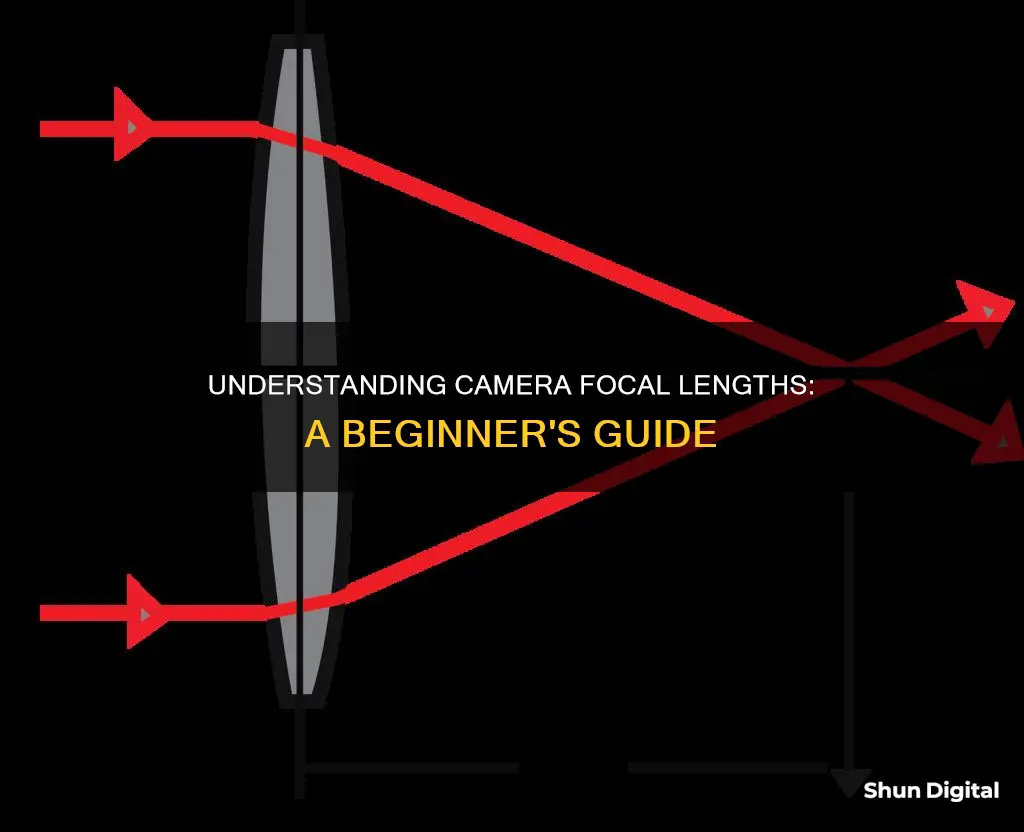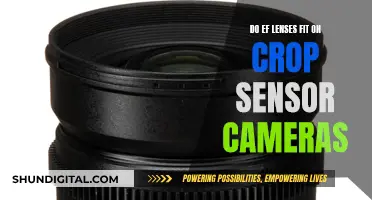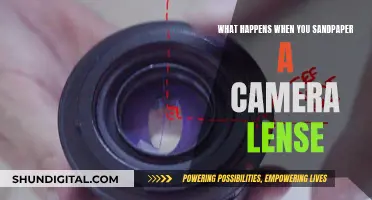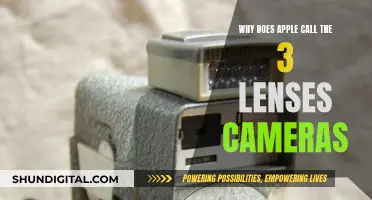
Understanding the focal length of a camera lens is key to understanding how your camera works. The focal length of a lens determines what your camera can focus on, and how your images will turn out.
The focal length of a lens is the distance, usually measured in millimetres, between the optical centre of the lens and the camera's sensor, where light converges and information is recorded. This determines the lens's angle of view and field of view.
A lens with a short focal length will have a wide angle of view, while a lens with a longer focal length will have a narrower angle of view. The focal length also determines whether you capture a wide vista or a close-up of a distant subject.
Focal length is an important consideration when deciding which lens to use to capture a scene or subject. It is also important to understand the benefits of different focal lengths if your goal is to build a versatile kit for more complex shoots.
| Characteristics | Values |
|---|---|
| Definition | The focal length of a lens is the distance in millimetres between the nodal or optical centre of the lens and the camera's sensor. |
| What it affects | Focal length determines the lens's angle of view, how much of the scene will be captured, and how large or small the subject will appear in the photo. |
| Focal length and perspective | Focal length determines perspective only when the photographer changes position relative to the subject to fill the frame. Wide-angle lenses exaggerate or stretch perspective, while telephoto lenses compress or flatten it. |
| Focal length and handheld photos | Longer focal lengths require shorter exposure times to minimise blurring caused by shaky hands. |
| Zoom vs. prime lenses | Zoom lenses have a variable focal length, while prime lenses have a fixed focal length. Zoom lenses are more convenient and offer more flexibility, but prime lenses are often smaller, lighter, and have better optical quality and larger apertures. |
| Focal length and type of photography | Focal length requirements vary depending on the type of photography. For portrait photography, 50mm is recommended for a head and upper body composition, while 85-90mm is better for a tighter view of the head and shoulders. For street photography, 35mm and 50mm are popular. For classic architecture images, an ultrawide angle lens in the 14-21mm range is often used. Landscapes can be shot with any focal length, but "classic" landscapes often use an ultrawide or wide-angle lens (16-24mm range). Wildlife and sports photography typically require a long telephoto lens, usually greater than 400mm. |
What You'll Learn

Focal length and field of view
The focal length of a lens is the distance between the lens and the plane of the sensor. This is determined when the lens focuses on an object at infinity. The focal length is usually measured in millimetres. The field of view is the total area that can be viewed by the lens and imaged onto the camera sensor. It is represented in degrees.
The relationship between focal length and field of view is as follows: the shorter the focal length, the wider the angular field of view (AFOV), and vice versa. For a given sensor size, a shorter focal length will result in a wider AFOV.
There are a few ways to change the field of view of a system. One way is to use a varifocal or zoom lens, which allows for adjustment of the focal length and, therefore, the AFOV. Another way is to change the working distance (WD) from the lens to the object. Moving the lens farther away from the object will increase the field of view. A third option is to change the size of the sensor; a larger sensor will yield a larger field of view for the same WD.
It is important to understand the relationship between focal length and field of view when choosing a lens for a specific application. The choice of lens will depend on the desired field of view and the sensor being used.
Lens Compatibility: EF-S Cameras and EF Lenses
You may want to see also

Focal length and perspective
The focal length of a lens determines what your camera can focus on and what part of a scene will be captured. It is the distance between the plane of the sensor and the optical centre or nodal point of the lens. This then determines the lens's angle of view. The longer the focal length, the narrower the area of the scene captured by the lens.
Perspective, in the context of photography, is the appearance of objects to the eye based on their spatial attributes and the position of the eye relative to the objects. In other words, it is how objects appear to the eye according to their distance and position.
While it is often said that focal length influences perspective, this is not strictly true. Changes in focal length do not directly influence perspective. Perspective is influenced only by the relative positions of the subjects in a scene with respect to the position of the camera. However, focal length can influence perspective indirectly. A given focal length allows you to move closer to or further from your subject, and it is this movement that determines perspective.
For example, a wide-angle lens has a shorter focal length, capturing a broader view. This makes objects in the foreground more prominent and exaggerates the distance between image planes. However, to fill the frame with the same subjects using a wide-angle lens as with a telephoto lens, you must move closer to or further from your subject, thus changing the perspective.
In summary, while focal length and perspective are interconnected, it is important to understand that changing the focal length of a lens does not directly change the perspective of an image. Perspective is influenced solely by the relative positions of the subjects and the camera.
EF-S Lenses: Full-Frame Camera Compatibility Explored
You may want to see also

Focal length and angle of view
The focal length of a lens is the distance between the plane of the sensor and the optical centre or nodal point of the lens. This determines the lens's angle of view. The longer the focal length, the narrower the area of the scene captured by the lens.
The focal length of a lens determines its angle of view, and how much the subject will be magnified from a given photographic position. Wide-angle lenses have short focal lengths, while telephoto lenses have longer corresponding focal lengths.
The angle of view in photography is the area of the scene that is captured by the camera sensor, described in degrees of coverage in front of the camera. This is used interchangeably with the more general term "field of view".
The focal length of a lens is described in millimetres (mm). The longer the focal length, the longer the lens will be. Lenses with a wider view will have a shorter focal length and are physically shorter by comparison.
A short focal length is considered anything below 35mm. These lenses have an expansive field of view that's wider than what we normally pay attention to. An image taken with a 15mm lens will seem abnormally expansive, taking in an entire landscape, for example.
A long focal length is considered anything over 50mm. This view is narrower than the normal view we're accustomed to. An image taken with a 100mm telephoto lens will have a much smaller section of coverage than a normal or wide-angle field of view.
Standard focal lengths range from 35mm to 50mm depending on the type of camera sensor. The field of view provided by standard focal lengths approximates the field of view of the human eye.
A camera's angle of view depends not only on the lens but also on the sensor. Digital sensors are usually smaller than 35mm film, and this causes the lens to have a narrower angle of view. In everyday digital cameras, the crop factor can range from around 1 (professional digital SLRs) to 1.6 (consumer SLRs) to 2 (Micro Four Thirds ILC) to 6 (most compact cameras).
The combination of focal length and sensor size defines the diagonal angle of view, which is a measure of the angle between the two farthest-separated points in the frame, the diagonally opposite corners.
Testing Camera Lenses: A Step-by-Step Guide
You may want to see also

Focal length and distance
The focal length of a lens also determines its angle of view and how much the subject will be magnified from a given distance. Wide-angle lenses have shorter focal lengths, while telephoto lenses have longer ones. The focal length of a lens may also impact how easy it is to take a sharp handheld photograph, as longer focal lengths require shorter exposure times to minimise blurring caused by shaky hands.
It's important to note that the perspective of an image is determined by the photographer's location relative to the subject, not by the focal length. However, if you try to fill the frame with the same subject using both a wide-angle and a telephoto lens, the perspective will change because you will need to move closer or farther from the subject. In this case, the wide-angle lens will exaggerate or stretch the perspective, while the telephoto lens will compress or flatten it.
Lenses can be divided into two types: prime and zoom. Prime lenses have a fixed focal length, while zoom lenses offer variable focal lengths. Zoom lenses are more convenient as you can carry just one lens to be prepared for various shooting situations. However, prime lenses are smaller and lighter, offer better optical quality, and have larger apertures.
Building Custom Camera Lenses: A Step-by-Step Guide
You may want to see also

Focal length and aperture
Focal length is a basic description of a photographic lens, usually represented in millimetres (mm). It is the distance from the centre of the lens to the imaging point (focal plane) where light for the image is collected. It is not a measurement of the actual length of a lens but a calculation of an optical distance. The focal length of a lens determines its angle of view and how much of a scene will be captured.
The focal length of a lens also determines the lens's field of view. The longer the focal length, the narrower the area of the scene captured by the lens. This means that a lens with a short focal length captures a much broader view than a telephoto lens.
There are two types of lenses: prime and zoom. Prime lenses have a fixed focal length, whereas zoom lenses have variable focal lengths. Prime lenses are usually more compact and lightweight than zoom lenses. They also tend to have a larger maximum aperture (f/1.4 to f/2.8). This is an advantage when shooting in low-light conditions as it increases the possibility of handheld shooting, freezing the subject without shake or blur caused by longer exposures.
The aperture is the opening at the rear of the lens that determines how much light travels through the lens and falls on the image sensor. The size of the aperture's opening is measured in f-stops. A small f-number corresponds to a larger or wider aperture size, which results in a shallow depth of field. Conversely, a large f-number results in a smaller or narrower aperture size and therefore a deeper depth of field.
The aperture range identifies the widest to the smallest range of lens openings, from f/1.4 (on a super-fast lens) to f/32. Each f-number represents one "stop" of light, with each movement up or down the range halving or doubling the amount of light passing through the lens.
Best Places to Sell Your Camera Lenses Online
You may want to see also
Frequently asked questions
Focal length is the distance in millimetres between the nodal or optical centre of the lens and the camera's sensor.
Focal length determines the lens's field of view, so it affects how much of the scene is captured. It also determines how large or small the subject of your photo will appear.
A short focal length has a wide angle of view, while a long focal length has a narrower angle of view. A short focal length will make your subject appear smaller, while a long focal length will make it appear larger.
A prime lens has a fixed focal length, meaning you can't zoom in or out.
A zoom lens has a variable focal length, meaning you can adjust the focal length within a predefined range.







